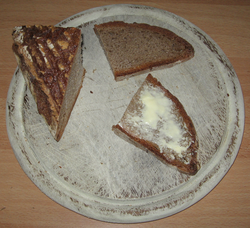Butterbrot: Difference between revisions
m Reverted edits by 209.90.93.118 (talk) to last version by VolkovBot |
Felizdenovo (talk | contribs) m →External links: +ka |
||
| Line 33: | Line 33: | ||
[[de:Butterbrot]] |
[[de:Butterbrot]] |
||
[[fr:Tartine]] |
[[fr:Tartine]] |
||
[[ka:ბუტერბროდი]] |
|||
[[nl:Boterham]] |
[[nl:Boterham]] |
||
[[nds-nl:Brukjen]] |
[[nds-nl:Brukjen]] |
||
Revision as of 17:16, 12 July 2008
The German word "Butterbrot" (literally: butterbread = bread with butter) describes a slice of bread topped with butter. The words in the different dialects for it vary from "Butterstulle", "Stulle", "Schnitte", "Bütterken" to "Bemme" or "Knifte". "Butterbrot" has been borrowed into Russian: Бутерброд. Until recently it was a very common staple food in Germany.


Butterbrot versus Sandwich
It exists in different variations (mainly with cold meat or cheese on top of the butter, jam and Nutella being modifications reserved for breakfast). For easier handling it can be folded and as such resembles the sandwich.
There is an important difference between the derivatives of the British sandwich and the butterbrot of the German-speaking countries: It is usually made from Graubrot (grey bread) which has a sour taste and contains rye, due to the use of sourdough as a leavening agent. As Graubrot requires the culture of rye, which implies sourdough, and widespread dairy farming, most south-/western-European countries came to prefer other kinds of (mainly white) breads, based on fast growing and therefore cheaper yeast (baguette, ciabatta, toast etc). Therefore, many Germans (especially older ones) quickly start to miss their beloved butterbrot from Graubrot when staying abroad for a longer time.
The decline of butterbrot
Butterbrot has been replaced gradually in the last 40 years by muesli, breakfast cereals or toast for breakfast and take-away bakery products during daytime. Some younger people in Germany eat butterbrot rarely, if at all.
Usually in September every year, the Central Marketing Society for German Agriculture (CMA, the agricultural industry's lobby group) declares a "day of the German Butterbrot". The 8th Butterbrot day's motto in 2006 was: "Re-Experience Enjoyment".[1]
Butterbrot is not declining in all parts of daily life. It is still very common on hiking trips. In many parts of Germany the butterbrot is still very common for second breakfast at school or work (much more often eaten than, for example, fast food).
Butterbrot urban legends
Butterbrots and their variants are said to always fall to the floor with the top side downwards (see: Murphy's law). Secondly the top side is usually heavier than the bottom side. This applies more to Nutella/jam breads than cheese/meat breads. The subject has been researched intensively by various sources, e.g. the famous children's series Die Sendung mit der Maus, and the scientific TV German series Quarks & Co. It is often joked about what would happen if you tie a butterbrot to the back of a cat. Would the feline still honour the popular axiom, that a cat "always lands on its feet" if it falls, or would the butterbrot be "stronger" and make the cat fall on its back?
Sources
External links
- The butterbrot experiments and the different lines of thought (German)
- Resume of the experiments in Quarks & Co (German)
- Cartoon Translation: "Cats always land on their feet and butterbrots always land on the top side, what could be more interesting than strapping a Butterbrot on top of a cat and let them fall together." – "Poor butterbrot." This experiment refutes the claim that butterbrots always land on the top side.
